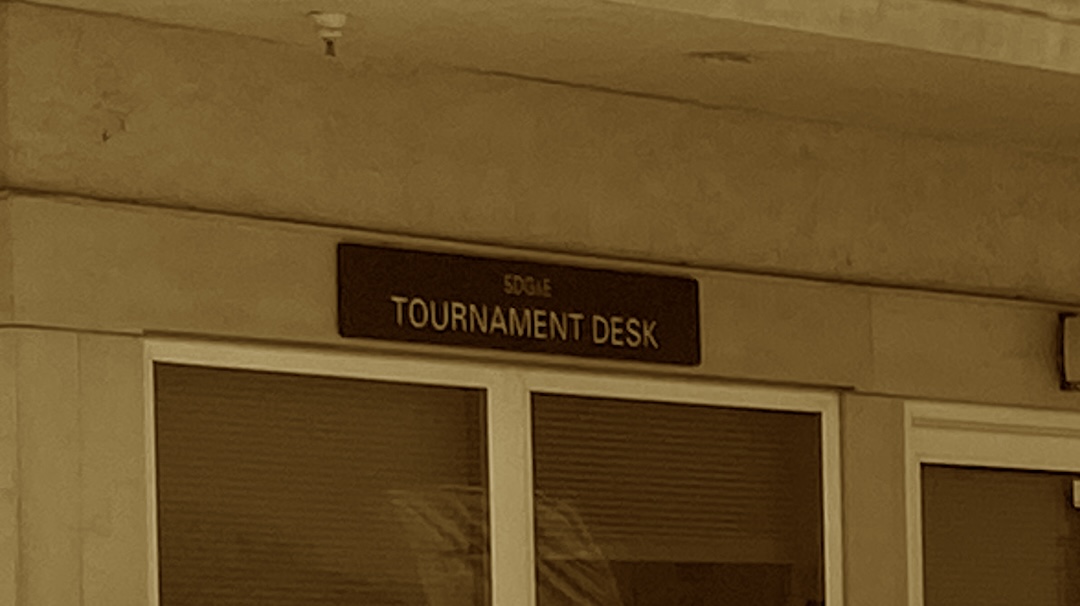During one of my matches at the National Senior Women’s Clay Court Championships last week, a roving official made a call that was an incorrect interpretation of tennis law. It was the first time I could have potentially summoned the tournament referee, but I opted not to do so. However, it is still an interesting thought exercise on exactly what the rules do (and do not) say.
To set up the situation, my opponent had hit a weak shot that barely cleared the net. I was able to easily tap the ball back into a wide-open court. After the ball had bounced twice (actually three) times, an umpire came running over from an adjacent court and yelled, “Let, let, let” and pointed to a ball that was rolling through the back corner of our court.
I told her that the point was already over before she uttered the first “let.” She actually agreed with my perception of the timing. However, she claimed that the call was justified and asserted that I saw her coming over from the adjacent court and knew she was about to call a let before I hit my shot. I did not. Even if I had, that’s not how let calls work.
For the record, my back was turned to her, and I did not see her approaching the court. Additionally, neither my opponent nor I realized that the ball had rolled onto the back of our court before she made the let call and pointed it out. Additionally, I am not convinced that the ball was even on our court before the second bounce of my winning shot. It was still rolling when the umpire alerted us to its presence.
I can see how an official relatively new to the sport might not understand this particular nuance. It isn’t explicitly stated that a let cannot be called after a point has ended anywhere in the rules. The closest that the USTA Friend at Court comes to directly addressing this situation is Principle 18 in “The Code.”
Let called when ball rolls on court. When a ball from another court enters the playing area, any player on the court affected may call a let as soon as the player becomes aware of the ball. The player loses the right to call a let if the player unreasonably delays in making the call.
Principle #18 from “The Code” in the USTA Friend at Court, 2023.
Hitting a completely open court with a sitter can sometimes be a challenge for me. It is interesting to wonder what would have happened had I missed the shot. The umpire and my opponent happened to be from the same local area. It would be cynical to wonder if the same call would have been made if I had missed the ensuing shot. However, I can state with full confidence that I would have insisted on conceding the point had the late let call been made after the alternative outcome.
Another principle in “The Code” also comes into play for a related reason. In fact, the scenario described is very similar, with the exception that I did not see the ball from the adjoining court.
Prompt calls eliminate two chance option. A player must make all calls promptly. A call must be made either before the player’s return shot has gone out of play or before an opponent has had an opportunity to play the return shot.
Prompt calls will quickly eliminate the “two chances to win the point” option that some players practice. To illustrate, a player is advancing to the net for an easy put away and sees a ball from an adjoining court rolling toward the court. The player continues to advance and hits the shot, only to have the supposed easy put away fly over the baseline. The player then claims a let. The claim is not valid because the player forfeited the right to call a let by choosing instead to play the ball. The player took a chance to win or lose and is not entitled to a second chance.
Principle #17 from “The Code” in the USTA Friend at Court, 2023.
I told the umpire that I thought her interpretation of tennis law was incorrect but agreed to replay the point as a let. We were a long way from the tournament desk, and it really wasn’t worth the time delay to summon the referee to the court. I quickly won the replayed point. “Ball don’t lie.”
In retrospect, I could have asked my opponent if she was willing to concede the point. The fact that she didn’t offer to do so may be a pretty good indication that she would not have agreed to that. However, I think it would be reasonable to make sure that she clearly understood the call that had been made to allow her to make her own well-informed decision before jumping to that conclusion.
The point was inconsequential to the match. However, it could have been if the same call had come at a more critical moment. For example, if it had transpired at 6-6 in a 3rd-set tiebreak game. In that case, the likelihood of referee intervention would have been significantly higher.
A friend recently gifted me his copy of the USTA Officiating Techniques and Procedures manual after he decided to stop officiating. Curiously enough, that document is almost completely silent on the roving official’s responsibilities and procedures when calling lets. The only explicit direction in that document is that the umpire should allow either player to make let calls.
Since it seems likely that I will eventually go through officiating certification, I have been using this episode as a thought exercise on what I would have done if officiating in the same situation. I think my philosophy will probably run along the lines of not injecting myself into match situations if it is not necessary. However, I won’t know for sure until I have walked a few miles in those shoes.
Officiating is hard. I genuinely appreciate every person who is willing to put themselves forward in that role.




Teresa / Summer,
You both have my sympathy! Officiating is not an exact science – there are areas where officials have to interpret a situation.
Teresa, you are correct… the official should not have injected herself into your match unless one of you were in danger from stepping on the errant ball. A good official is one who isn’t remembered!
Summer, you were robbed! if the ball had bounced out of court before an errant ball entered your playing area, the point was over as soon as your opponents shot bounced out of court.
If your opponents argued the point you should have claimed a hindrance after your opponents shouted loudly before the point was over.
‘Lets’ are not ‘get out of jail free cards’ to be used when necessary to obtain another chance to win the point!
I’ve had similar experience not being able find definitive rules to clarify situations when let is called for a ball comes from another court. Playing in playoffs this past weekend, we had 2 let calls made by our opponents that my partner thought were late calls. In the first case, the let was called right after my partner hit an angled volley to the alley. I wasn’t sure if the call was made before or after the ball bounced once. The ball actually rolled across our side of the court but we didn’t notice it because we were focused on the ball in play. Our opponents of course wanted to redo but my partner insisted that the shot was obviously a winner and they had no play on it and they called after she had hit the ball. We ended up taking the point. In the second case, our opponent hit the ball then called let because a ball rolled across the court on her side. The ball she hit was way out behind the baseline. We decide to redo that point because we didn’t want to get into another argument. After the match, I was curious as to how we should have called those two lets but didn’t find anything in the rules or friends of court to address it.
I did find this on TennisLife online magazine:
This past weekend, I hung out with some of my tennis pals, and we got into a discussion about something that happened to one of them during a doubles league match last week.
One of their opponents mis-hit an overhead off her racquet frame, resulting in a loopy floater that was obviously headed out. She knew it, too, and cussed out loud, but that wasn’t the issue. Since they were playing on a court adjacent to another line’s match, my friend moved out wide so she could stop the ball from going into the next court. Before the ball even bounced, a ball from the neighboring court rolled into their net on my friend’s side. The opponents immediately called a let and demanded to replay the point, however, my friends felt that no let should be given. After all, the ball was hit before the ball came onto the court, and it landed nearly 3 feet out!
So… who is right?
This one is covered in the 2019 Friend At Court Handbook of Rules and Regulations:
Rule #18: Let called when ball rolls on court.
When a ball from another court enters the playing area, any player on the court affected may call a let as soon as the player becomes aware of the ball. The player loses the right to call a let if the player unreasonably delays in making the call.
Sooooooooo… Even though the opponent who hit the ball verbally recognized her error before the other ball rolled into the net, she and her partner were still entitled to a let and to replay the point (two serves), which they did.